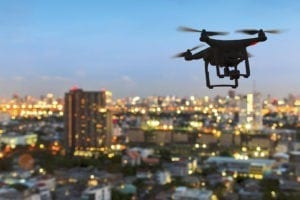
Silhouette of drone flying above city at sunset. (European Union)
With new legislation opening the door for testing, evaluating and eventually deploying systems to mitigate threats from unmanned aircraft systems that can be purchased commercially, the U.S. Department of Homeland Security plans to begin evaluating related technologies and systems in 2019.
Sandia National Laboratories, on behalf of the DHS Science and Technology Directorate, this month issued a Request for Information to help it identify commercial-off-the-shelf counter unmanned aircraft system (UAS) systems for evaluation next year to help make decisions about acquiring and deploying the systems. Sandia has done testing on counter UAS systems for the Department of Energy.
The notice, published in the government’s Federal Business Opportunity contracts pipeline, says commercially bought UAS “have quickly become a security concern due to the ease with which they can aid in intelligence gathering and/or be used as a malicious delivery platform. Federal agencies responsible for protecting facilities, personnel, and critical assets have begun realizing the immediate need for counter systems to these UAS.”
Already in foreign countries, small commercial drones have been used for lethal purposes. In Iraq, Islamic State militants have successfully modified and used these UAS to drop small bombs with precision and earlier this summer two drones armed with explosives were used in an unsuccessful assassination attempt against Venezuelan President Nichols Maduro.
In the U.S., DHS and other federal officials are concerned that similarly armed drones could be used against critical facilities, mass gatherings, or other targets. Already, drones are being used illegally for surveillance purposes, and smuggling drugs and contraband.
The counter UAS legislation has bipartisan support and was signed into law in October. The legislation allows DHS to test and evaluate counter drone systems and technology in the U.S., something previously prohibited to federal civilian agencies, and for the deployment of these systems by DHS and the Justice Department. The Defense and Energy Departments are already permitted limited deployments of counter UAS systems domestically to protect critical facilities but so far there have been few deployments.
Federal officials have said there are upwards of several hundred counter drone systems being marketed but that that solid data is lacking on the capabilities of most of these. Anh Duong, the program executive officer at DHS S&T for UAS systems said in June that in general there is a lack of data on testing and use of counter drone systems in domestic environments, particularly urban areas.
At a July hearing hosted by the House Transportation and Infrastructure Subcommittee on Aviation, David Silver, vice president of Civil Aviation at the Aerospace Industries Association, highlighted concerns around counter UAS systems that work by jamming the frequencies a drone is operating on. He said more data is needed on how this technology might affect the operation of legitimate aircraft that are nearby.
Responses to the RFI are due by Dec. 3. DHS says it will collect technical information on counter drone systems and compare it “against manufacturer specifications and claims.”